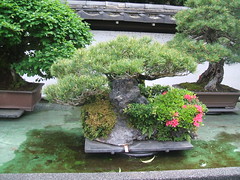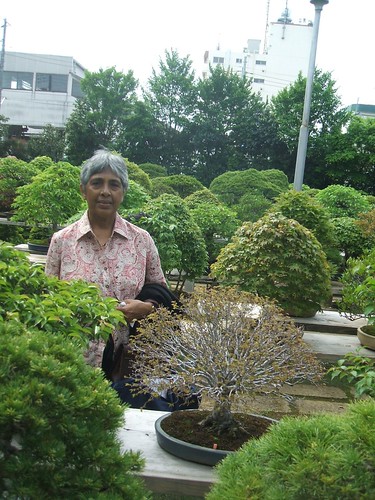Plant of the Month : Ficus Benghalensis
by Suganthi Aiyaswamy (a member Bodhi Bonsai Chennai.)
Ficus Benghalensis is commonly known as Banyan. It is a large and extensive growing tree of the Indian sub--continent .Due to the complex structure of the roots and extensive branching, the banyan is used for creating Bonsais.
The tree produces propogating roots which grows downwards, these aerial roots touch the ground and grow into woody trunks that become indistinguishable from the main trunk.
The leaves are oval in shape, thick and leathery glossy green with a smooth margin, and a short
petiole. Young leaves have an attractive reddish tinge to them.
Styles:
The trees can be trained into an informal upright style or can be placed over rocks
Soil :Red earth, sand and humus in equal amounts work well for ficus, The soil should be allowed to dry out between watering. Spray or mist the leaves .
Propagation: Soft wood cutting planted in soil takes root in 3 to 4 weeks Young trees need repotting every year. Do not remove more than 20% of the roots. Wiring can be done anytime of the year, but the wires should not be allowed to remain on the plant for more than a few months at a time
A banyan starts its life when its seeds germinate in the cracks and crevices on structures like buildings and walls, or on host trees. As they grow they strangle the host tree or building, so they are also called Strangler Fig.
The Banyan Bonsai is favoured by a lot of Bonsai growers since it is easy to take care. The aerial roots if properly controlled will improve the appearance with no risk of them spreading
outside the pot.
( This article is reproduced from April 2012 issue of 'Bodhi Bonsai News Letter' )
by Suganthi Aiyaswamy (a member Bodhi Bonsai Chennai.)
Ficus Benghalensis is commonly known as Banyan. It is a large and extensive growing tree of the Indian sub--continent .Due to the complex structure of the roots and extensive branching, the banyan is used for creating Bonsais.
 |
| Bonsai of Ficus Benghalensis |
The tree produces propogating roots which grows downwards, these aerial roots touch the ground and grow into woody trunks that become indistinguishable from the main trunk.
The leaves are oval in shape, thick and leathery glossy green with a smooth margin, and a short
petiole. Young leaves have an attractive reddish tinge to them.
Styles:
The trees can be trained into an informal upright style or can be placed over rocks
Soil :Red earth, sand and humus in equal amounts work well for ficus, The soil should be allowed to dry out between watering. Spray or mist the leaves .
Propagation: Soft wood cutting planted in soil takes root in 3 to 4 weeks Young trees need repotting every year. Do not remove more than 20% of the roots. Wiring can be done anytime of the year, but the wires should not be allowed to remain on the plant for more than a few months at a time
A banyan starts its life when its seeds germinate in the cracks and crevices on structures like buildings and walls, or on host trees. As they grow they strangle the host tree or building, so they are also called Strangler Fig.
The Banyan Bonsai is favoured by a lot of Bonsai growers since it is easy to take care. The aerial roots if properly controlled will improve the appearance with no risk of them spreading
outside the pot.
( This article is reproduced from April 2012 issue of 'Bodhi Bonsai News Letter' )













